
Digital Mapping Techniques '04— Workshop Proceedings
U.S. Geological Survey Open-File
Report 2004–1451
Process of Converting Geologic Maps from Coverages to Geodatabases
U.S. Geological Survey, Western Earth Surface Processes Team, 345 Middlefield Rd., MS-973, Menlo Park, CA 94025; Telephone: (650) 329-4935; Fax: (650) 329-4936; e-mail: kwheeler@usgs.govINTRODUCTION
The Pacific Northwest Urban Corridor Geologic Mapping project is providing digital 1:24000-scale geologic mapping of areas in western Oregon and Washington. Our databases are online, with documentation describing the datasets at http://geology.wr.usgs.gov/wgmt/pacnw/.
Online releases from 1995–2002 include:
In 2002, we began using ArcGIS for database management and map creation. The data structure for our databases followed the Alacarte standard (Fitzgibbon, 1991; Fitzgibbon and Wentworth, 1991; Wentworth and Fitzgibbon, 1991).
Our project has converted almost all our pre-existing coverages from Workstation ArcInfo to ArcGIS geodatabases.
Current packages produced for the website include:
We now are adding more data to our geodatabases, improving our collection of data with ArcPad, developing styles for ArcMap which make the maps more uniform, streamlining the map production with templates, and improving our metadata. A downloadable PDF of our DMT ’04 poster is available at http://ngmdb.usgs.gov/Info/dmt/docs/wheeler04.pdf(15MB).
CONVERTING COVERAGES TO GEODATABASES
A typical conversion of one geology map from coverages to a Geodatabase takes about 10 minutes or less.
1. Use ArcCatalog to create a Personal Geodatabase
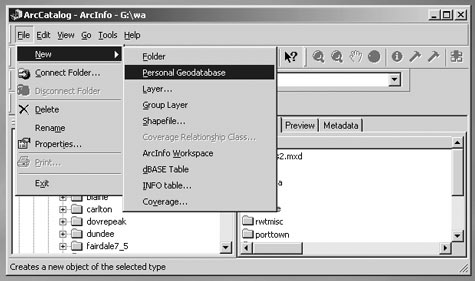 |
Figure 1a. Open ArcCatalog and create a Personal Geodatabase. Rename the geodatabase with a name that you or your organization prefers. |
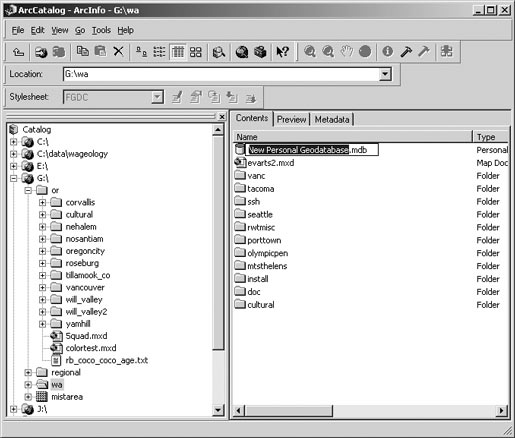 |
|
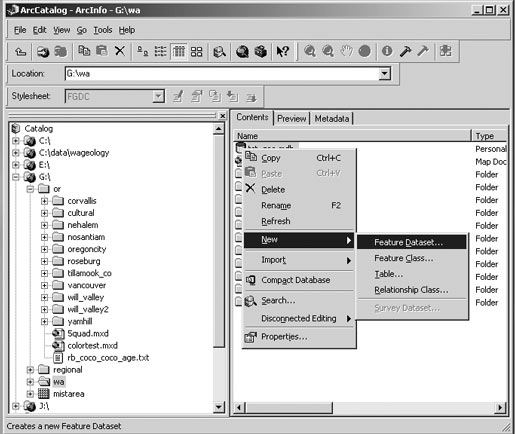 |
Figure 1b. Add Feature Datasets (such as geology, locations, and structure) in ArcCatalog. Create a Feature Dataset in that geodatabase (right click the name of the geodatabase). Name the Feature Dataset and click the Edit button to choose a projection. |
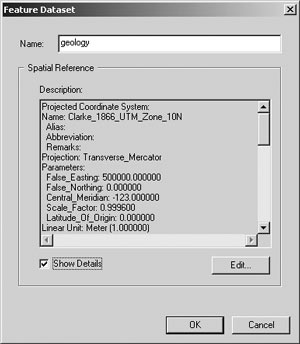 |
 |
Figure 1c. Create a Feature Class in that Feature Dataset or import coverages into the Feature Dataset as Feature Classes in ArcCatalog (right click the name of the dataset). Type in the Name of the new Feature Class, then click which Type of Feature Class, and click Next button. Or you might import preexisting coverages or shapefiles to the Feature Dataset as Feature Classes. |
 |
Figure 1d. Use ArcCatalog to specify Domains for the Geodatabase which will later
be attribute choices in Arcmap as features are attributed. To create Domains,
start ArcCatalog. Right-click on your previously created Geodatabase and
select Properties (see top left group of images). Type in a new Domain
Name (e.g., 'water_body'). Click the field to the right of Field Type and
select a type (such as Text). Enter the Coded Values with Description for
your tags. Click Apply and OK, and exit from ArcCatalog. Start ArcMap,
open a Map Document, which has the geologic data in it, or add the data
to it (see top right group of images, and Figures 2a and 2b). Right click
the Feature Class to link the Domain, and click Open Attribute Table. On
the Attribute Table, click the Options button, and select Add Field. Type
in the Name of the new field (e.g., 'water'). Click the drop arrow to right
of Type and select Text. Click to right of Domain and select the Domain
previously created in ArcCatalog. Click OK. The attribute table will now have the new field in it, appended at the end (see image in the
second row). Save ArcMap, and start an Edit Session (see left image in
third row). Click in a record to tag, select a tag from the drop menu,
and tag feature (e.g., as 'lake'; see right image in third row). Save edits
(see image at bottom). Save ArcMap Document. |
2. Use ArcMap to symbolize a Geologic Map of the Geodatabase
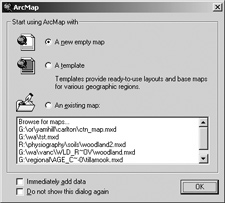 |
Figure 2a. Create a new Map Document in ArcMap. Open ArcMap and create a New Map Document. Right click the Layers in the Table of Contents frame, and specify the Coordinate System, and scale. |
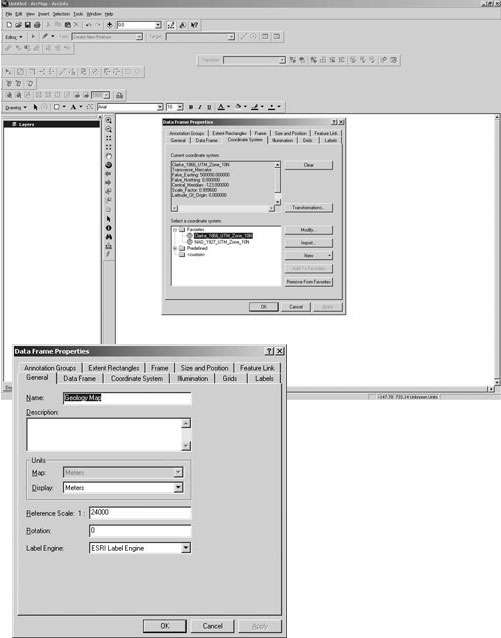 |
|
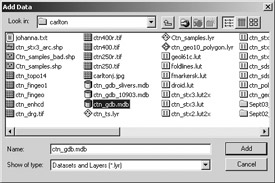 |
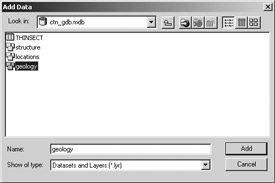 |
Figure 2b. Add data from newly created geodatabase in ArcMap. Add data (the yellow button with plus symbol), and select the Geodatabase previously created with Dataset (see two images in top row). It plots with default symbols (see middle image), but you can easily change that with a lookup table (see bottom image), with a style, or by specifying each one individually in the Layer Properties > Symbology tab. |
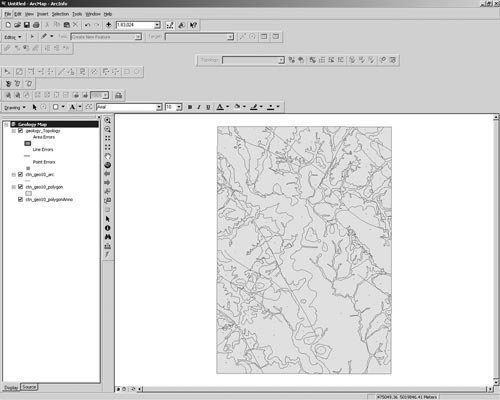 |
||
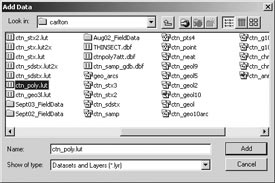 |
||
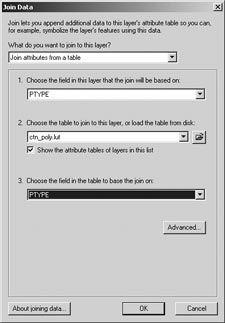 |
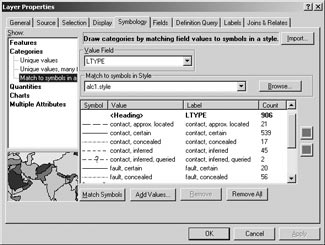 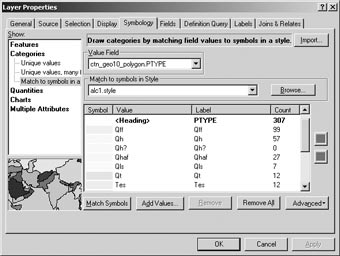 |
Figure 2c. Use Styles or a previous Layer file for symbology in ArcMap. To symbolize with the Lookup Table, join the table to the polygons (top left image). Bring up the Layer Properties for the Polygons, Symbology Tab (top right image), and choose “Categories > Match Symbols in a Style”. Select Value field, then the Style, and click the Match Symbols button (middle image). Styles are edited using the Style Manager in ArcMap, and may be shared among ArcGIS desktop users. Select “Tools > Styles > Style Manager” to chose a Style that you’ve received from another ArcGIS user. Right click on the Name, copy and paste, edit new symbol by Properties. The bottom image shows lines symbolized with a style, not a lookup table. |
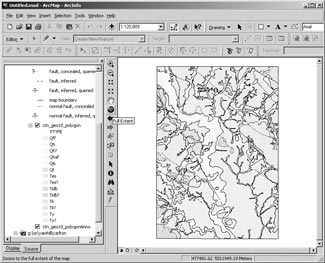 |
||
3. Exporting from ArcMap
 |
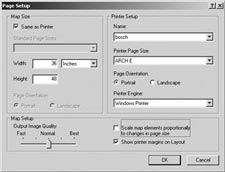 |
Figure 2d. Export the map from ArcMap, at a specified scale, to EPS or to Adobe Illustrator. In the Data View (top left image), click the Full Extent (Globe button) so that map is zoomed out. Then click the Layout View (second row left image). Click “File > Page Setup”. Choose plotter, paper size, and orientation of page (upper right image). Also deselect the Scale map to page size box, or the map will not be a true scale. If the frame of the map is small, click the corner with the arrow tool and drag it to the larger size (bottom row left image). Then specify map scale in the box at the top. Click “File > Export”, and name the file for exporting (bottom row right image). From the drop list, choose the type of file (here, Illustrator). Click the Export button. The file will be created, and should open in Adobe Illustrator. If this doesn’t work well, try other formats for exporting. |
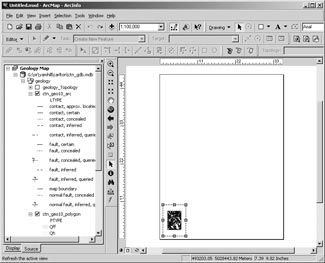 |
||
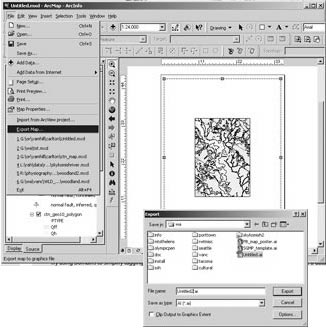 |
||
PUBLISHED GEODATABASES
Our latest geologic map, published as a geodatabase, was presented on our poster at the Workshop. It was originally compiled on mylar and greenlines, scanned, and digitized into Workstation ArcInfo. It was imported into a Personal Geodatabase, edited in ArcMap, and exported to a graphic file for Illustrator.
Our project’s first geodatabase, Maps showing Inundation depths, ice-rafted erratics, and sedimentary facies of the Late Pleistocene Missoula Floods of the Willamette Valley, Oregon, was published in 2003 and is online at http://geopubs.wr.usgs.gov/open-file/of03-408/. It consists of shapefiles, a geodatabase and metadata, PDFs of maps, and a readme file.
Our most recent geodatabases are best found by visiting our website and clicking the “What’s New” tab or at http://geology.wr.usgs.gov/wgmt/pacnw/new.html. We keep it updated with the latest publications.
FUTURE DIRECTIONS
We are testing ArcPad on an IPAQ-brand Personal Digital Assistant (PDA) with GPS (see paper by Thoms and Haugerud, in these Proceedings). For base maps in ArcPad, we use ArcCatalog to export the DRGs to MrSID compressed-format images. Forms developed in ArcPad are used to collect for each point our data for sample locations, structural measurements, geologic unit, date, time, and also general field notes. Collecting data for points in ArcMap allows us to directly use the information as Shapefiles, and saves time digitizing the points from paper field sheets as was previously done. Once we created a geologic map in ArcGIS, the Geodatabase was exported to ArcPad and used in the field on the IPAQs to add more information; later the file was reimported to the Geodatabase to update the geologic map.
On Windows CE running on Compaq IPAQs, the file navigation software was awkward, so we found it necessary to purchase an inexpensive utility called PE File (HeavenTools software, http://www.heaventools.com/), to better view filename lists with extensions. Our cost has been minimal for these IPAQs and the PE File software.
We are now trying to use ArcSDE for multiuser editing of Geodatabases and for managing large image catalogs, but this is only in the testing phase. It is simple to convert the ArcGIS Personal Geodatabases to ArcSDE databases. We are have migrated from ArcGIS 8.3 to ArcGIS 9, and are adopting a new ArcGIS geologic map database structure and symbolsets.
ADDITIONAL TIPS
REFERENCES
Fitzgibbon, T.T., 1991, ALACARTE installation and system manual (version 1.0): U.S. Geological Survey Open File Report 91–587B, 66 p.
Fitzgibbon, T.T., and Wentworth, C.M., 1991, ALACARTE user interface—AML code and demonstration maps (version 1.0): U.S. Geological Survey Open File Report 91–587A, 10 p.
Wentworth, C.M., and Fitzgibbon, T.T., 1991, ALACARTE user manual (version 1.0): U.S. Geological Survey Open File Report 91–587C, 268 p.